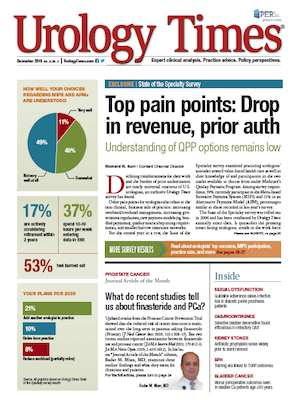Publication
Article
Urology Times Journal
Guideline adherence raises infection risk in diabetic penile prosthesis patients
Author(s):
Guideline-directed care often leads to better outcomes, but that’s not the case with the AUA’s antibiotic prophylaxis guidelines for diabetic patients undergoing primary penile prosthesis implantation. Authors of an ongoing study have found that adhering to the antibiotic prophylaxis guidelines results in a five-fold increased infection risk among diabetic penile prothesis patients, greatly increasing their risk for explantation.
RFBSIP - stock.adobe.com

Guideline-directed care often leads to better outcomes, but that’s not the case with the AUA’s antibiotic prophylaxis guidelines for diabetic patients undergoing primary penile prosthesis implantation. Authors of an ongoing study have found that adhering to the antibiotic prophylaxis guidelines results in a five-fold increased infection risk among diabetic penile prothesis patients, greatly increasing their risk for explantation.
Study author Maxwell Towe, BS, presented the data at the AUA annual meeting in Chicago. He said the AUA recommends antibiotic prophylaxis prior to penile prosthesis implantation with an aminoglycoside and either a first- or second-generation cephalosporin or vancomycin. But the AUA states on its website that there are no randomized trials assessing the efficacy of the current recommendation.
An infection requiring device explantation is the most devastating complication post penile prosthesis implantation, the authors wrote.
Also see: Evidence-based PCa care more likely in multidisciplinary setting
“The fact that these guidelines resulted in worse outcomes for these patients is something that really needs to be taken seriously,” according to Towe, clinical research fellow at the University of California, Irvine, working with Faysal A. Yafi, MD, and colleagues.
The authors studied 603 diabetic patients undergoing primary penile prosthesis implantation between April 2003 and May 2018 at 17 high-volume institutions.
In an average 7-month follow-up, the authors found 3.8%, or 23 of the patients, had a postoperative infection, 4.8% (29 patients) had their device explanted, and 5.5% (33 patients) required revision. Clinicians followed AUA prophylaxis guidelines in 36.5%, or 282 patients, with 220 receiving gentamicin and vancomycin and 62 patients receiving gentamicin and a cephalosporin. The remaining 321 patients, representing more than half of those studied, received prophylaxis that differed from the AUA’s recommendations.
Patients in the AUA guidelines group had significantly higher rates of infection and explantation but similar revision rates. Infections occurred in 6% of patients who received AUA-recommended antibiotic prophylaxis versus 1.9% in the non-AUA group. The rate of explantations was 8.2% in the AUA group compared to 1.9% in the non-AUA group.
Next: Addition of fluoroquinolone lowers infection rateAddition of fluoroquinolone lowers infection rate
Further digging revealed the infection rate for those treated with gentamicin and vancomycin was 7.73% and decreased to 1.04% when clinicians added a fluoroquinolone to the regimen. Explantation rates fell from 9.6% to 1.0% and revisions from 8.2% to 3.1% with the addition of a fluoroquinolone.
Adding an anti-fungal to gentamicin and vancomycin non-significantly lowered infection, explantation, and revision rates, the authors reported.
“This project is ongoing,” Towe said. “We’re still collecting patient data, hoping to get 200-plus more patients to add to our database. We’re also looking more at the ones that did get an infection. We’re looking at their cultures to see specifically which types of organisms are being grown in order to understand why the AUA guidelines were not effective for preventing infection.”
Read: New data point to statins’ potential for reducing prostate growth
At this point, the research falls short of helping urologists with how best to avoid penile prosthesis infections in diabetic patients. Future research should look at whether factors such as antibiotic timing and dosing impact infection risk, Towe said.
“If we can identify a certain issue with perioperative antibiotic prophylaxis, then maybe it might be time to change the guidelines and try and figure out what the best solution or drug regimen that can prevent postoperative infection,” he said. “The overall message... is that guidelines should be used as guides. They’re not the Holy Grail of how to manage patients. Sometimes it’s important to revisit and reevaluate those guidelines to make sure they’re actually effective at preventing harm in patients and that adherence to them will provide the best quality of care.”




